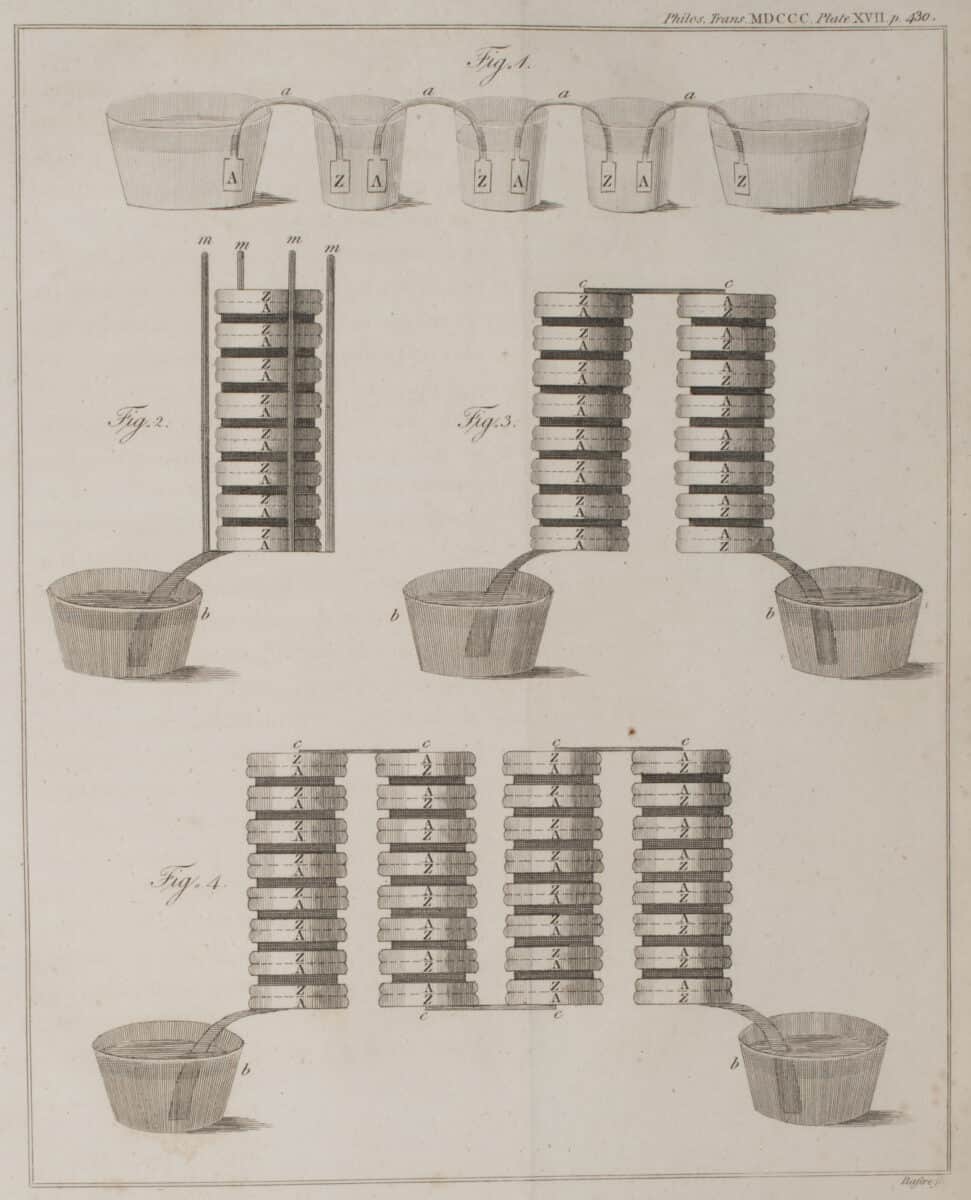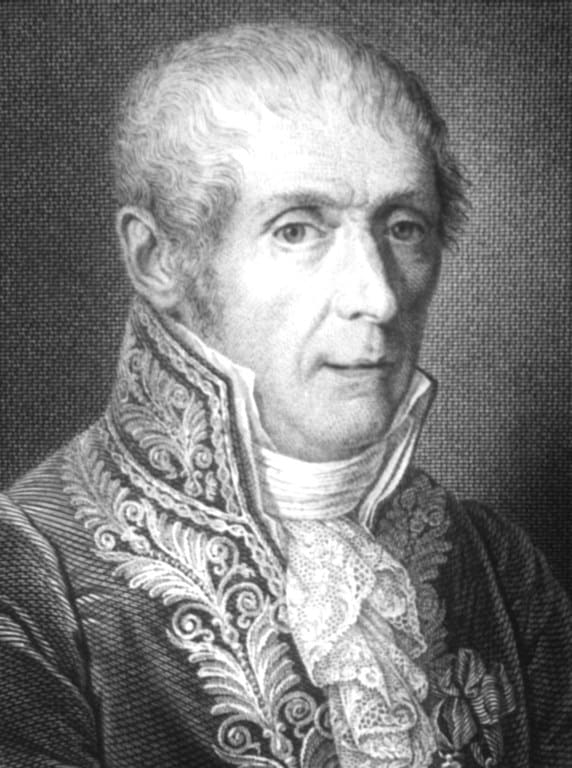Key Points:
- Alessandro Volta is known for discovering methane gas (1776) and inventing the world’s first electric battery.
- Napoleon Bonaparte gave Volta the title of count and senator of the kingdom of Lombardy after he presented his voltaic pile to the emperor in 1801.
- Volta made discoveries in other areas including voltage, electrical condensers, electroscopes, the behavior of gases, and electric conductors.
Alessandro Volta (1745-1827) was an Italian scientist, inventor, and physics professor that contributed major discoveries in electricity and chemistry. He is known for discovering methane gas (1776) and inventing the voltaic pile (1800), known as the world’s first electric battery.
With a noble yet confounding upbringing, Volta worked as a renowned physics professor at the University of Pavia. Over his 40-year career, Volta would go on to inspire many celebrated physicists of his time, including Carl Friedrich Gauss, Michael Faraday, and André-Marie Ampère.
Quick Facts
- Full Name
- Alessandro Giuseppe Antonio Anastasio Volta
- Birth
- February 18, 1745
- Death
- March 5, 1827
- Net Worth
- N/A
- Awards
- Copley Medal
- Legion of Honour
- Order of the Iron Crown
- Children
- Three
- Nationality
- Italian
- Place of Birth
- Como, Lombardy
- Fields of Expertise
- [“Physics”]
- Institutions
- University of Pavia
- Contributions
- first electric battery, discovery of methane gas
Early Life
Alessandro Volta, named Allessandro Giuseppe Antonio Anastasio Volta, was born in Como, Lombardy on February 18, 1745. His parents were Filippo Maria Volta, a noble of the municipality of Como, and Maria Maddalena Inzaghi, from a distinguished Italian family. He was the youngest of seven children, with three sisters and three brothers that all survived until adulthood.
While Volta’s family derived from a noble heritage, they were not wealthy. Alessandro’s father, Filippo, passed away shortly after his birth, leaving his mother and siblings with several unpaid debts. To help ease the family’s struggle, Alessandro moved to the home of one of his uncles, who taught him until the age of 12. While slow to start (he did not learn to speak until age four), Volta showed promise in languages and science.
Alessandro was admitted into the Royal Seminary in Como in 1757, where he quickly learned to speak Latin, French, English, and German while studying Law. Yet, after Jesuit clergy started pressuring him into the priesthood, he was withdrawn from the seminary and transferred to another. This would prove futile for his family, for Volta had made up his mind years ago; He had decided at an early age to pursue a career in chemistry and physics.
At the age of 18, Volta dropped out of seminary school in favor of experimentation. At the time, he had already established correspondence with two prominent scientists. Jean-Antoine Nollet (who discovered osmosis) and Giovanni Battista Beccaria advised Volta to experiment more. Beccaria would also become an inspirational figure for Volta’s scientific aspirations.
Career
Chair of Experimental Physics, the University of Pavia
Without completing formal education, Volta had to build his reputation in the scientific community. With the help of his friend Giulio Gattoni and his personal library, alongside the guidance of Beccaria, Volta published his first and most notable dissertation, On the Attractive Force of the Electric Fire, and on the Phenomena Dependent on It. This, among other scientific studies and papers, earned him a role teaching physics at public schools across the municipality.
From 1774-1778, Volta continued his experiments while teaching at the public school. During this time, he made significant discoveries in static electricity, methane gases, internal combustion, and eudiomedic testing. He traveled across Europe, sharing his discoveries with other scientists and further increasing his reputation.
Volta’s efforts paid off in 1778 when he was appointed to the Chair of Experimental Physics at the University of Pavia. He would spend the rest of his professional career at the university, teaching students and continuing his scientific pursuits. Alongside notable physicists such as Antoine Lavoisier and Benjamin Franklin, Volta would go on to make incredible discoveries in several areas, including:
- Electrical potential (voltage)
- Electrical condensers (or capacitors)
- Electroscopes
- The behavior of gases
- Electric conductors and contact theory
- The invention of the voltaic pile (also known as the first battery)
Volta continued to assist the studies of notable scientists, such as William Nicholson, Hans Christian Oersted, and Michael Faraday with his invention. After a 40-year career at the university, he retired to a quiet life near his hometown with his wife and children.
What Is Alessandro Volta Known For?
Discovery of Methane
While exploring the wetlands around Lake Maggiore in Italy, Volta collected gas bubbles which he called “inflammable air native to marshes.” Now known as methane, the scientist experimented with the gas and discovered that it could explode using an electric spark. This discovery became the foundation of the internal combustion.
The Invention of the Voltaic Pile
In correspondence with Luigi Galvani, a physicist that studied the nature of electricity in animal tissue, the two scientists came to a disagreement.

During the dissection of a frog hanging from a brass hook, Galvani saw a contraction of a leg when touched by his metal scalpel. He determined that the fluid within the frog generated electricity when touched by an outside source, which he called animal electricity. Volta, however, believed the cause was due to the contact of the two metals, bridged with the fluid from within the frog.
He tested this theory in an effort to prove his friend wrong. What he discovered was a correlation between the frog’s legs and two metals of different composure. From here, Volta tested different fluids and concluded that as long as the metals were connected with something moist, they would produce electric potential.
From here, Volta connected more pairs of metals and discovered that he could produce even more voltage. He piled discs of silver and zinc (for a constant electromotive variable) and combined them with cards soaked in salt water. Producing a significant amount of voltage, he invented the first electric battery.
Alessandro Volta: Marriage, Children, and Personal Life
Marriage
Allesandro Volta married at the older age of 49 (it was typical for Italian men in the 18th century to marry by their 30s). After a failed love affair with Marianna Paris, a famous singer, he pursued marriage with Maria Teresa Alonsa Peregrini. Yet, because she was the youngest of seven daughters, the marriage was postponed until 1794, after her sisters had wed. Their partnership was amicable, as they stayed married until Volta’s death.
Children
Allesandro and Maria Teresa had three children: Zanino, Flaminio, and Luigi Tobia. Flaminio passed away at the age of 18, leaving him broken-hearted in his last years. While these three children are the only ones consistently recorded, there is speculation that Volta had as many as eight.
Tragedy
Allesandro Volta passed away in 1827, in his hometown of Como. At the age of 82, Volta spent the rest of his years with his wife and children. The Tempio Voltiano celebrates his legacy, built as a museum and memorial explaining his work. The museum also has some of his tools and equipment on display.
Alessandro Volta: Awards and Achievements
Achievements Earned During His Life
Volta was a distinguished and renowned scientist during his time as a physics professor at the University of Pavia. After exhibiting his voltaic pile to Napoleon in 1801, the emperor of France (and Italy at the time) bestowed upon Volta the title of count and senator of the kingdom of Lombardy. He also received several other special honors, including:
- The Copley Medal (an award from the Royal Society)
- The National Order of the Legion of Honor (the highest French order of merit)
- The Order of the Iron Crown (the highest Italian order of merit, now extinct)
- Director of the philosophical faculty at the University of Padua

©Le Petit Journal, Public domain, via Wikimedia Commons – Original / License
Posthumous Honors
Alessandro Volta’s discoveries in electricity were integral to the advancement of the study. In 1881, scientists named the unit of electric potential the volt in honor of his contributions. From 1990-1997, he was depicted on the Italian Lire. And in 2019, marine biologists, in a great display of wit and irony, named the electric eel species Electrophorus voltai in honor of the scientist that debunked the theory of “animal electricity.”
Alessandro Volta’s Published Works
On the Attractive Force of the Electric Fire, and on the Phenomena Dependent on It
Volta explains his ideas on the attractants and repellents of electricity in regard to gravity. He suggests that electrical attraction is invoked with distance. This would eventually support his notion that two metals, when connected with moisture, create electric potential.
Alessandro Volta Quotes
- “You must be ready to give up even the most attractive ideas when experiment shows them to be wrong.”
- “The language of experiment is more authoritative than any reasoning: facts can destroy our ratiocination—not vice versa.”
Up Next…
- Steam Man of Zadoc Dederick Explained — Everything You Need To Know Meet Steam Man, the earliest prototype resembling a robot ever invented in the US.
- Discover DATAR: The Early War Computer! Curious about how one of the earliest war computers functioned? Then read this fascinating article about DATAR.
- Shakey the Robot Explained: Everything You Need to Know Shakey the Robot was the first of its kind to have perception about its surroundings. Check it out here.
The image featured at the top of this post is ©ETH Library, Public domain, via Wikimedia Commons.







